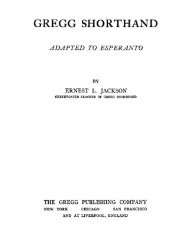GREGG SHORTHAND DICTIONARY
GREGG SHORTHAND DICTIONARY
GREGG SHORTHAND DICTIONARY
Create successful ePaper yourself
Turn your PDF publications into a flip-book with our unique Google optimized e-Paper software.
<strong>GREGG</strong> <strong>SHORTHAND</strong> <strong>DICTIONARY</strong> vii<br />
Quicker. slower. If. however, the adjective is written in full and ends ina<br />
straight line, the reversing principle is used for the comparative form, as in<br />
larger, later; when a brief form ends with the last consonant of a word, the<br />
reversed circle is used to make the comparative form after straight lines, as in<br />
sooner. stranger; after brief forms. abbreviated words, and words ending in a<br />
reversed circle. a disjoined r is used. as in worker, purer, nearer, unless<br />
the joined form is distinctive, in which case it may be used, as in smaller,<br />
greater.<br />
The termination est is expressed byes in words ending in a consonant<br />
when the word is written ;in full, as in cheapest, broadest. This rule also<br />
applies to brief forms or contractions when the final consonant of the shorthand<br />
form is also the final consonant of the word, as in soonest, strangest.<br />
The termination est is usually expressed by a disjoined st after brief<br />
forms, abbreviated words, or words ending in a vowel, as in stillest, busiest.<br />
but the st may be joined when a distinctive form is obtained, as in fuliest,<br />
truest.<br />
FORMATION OF ADVERBS. Adverbs formed by the addition of ly to the<br />
adjective are written in shorthand by adding the small circle, signifying ly,<br />
to the primitive form of the adjective. The only exceptions to this rule are<br />
friendly, immediately, thoroughly, respectfully.<br />
THE ENDING TION<br />
So many words end with the suffix tion, in its various spellings, that in<br />
forming derivatives a shorthand outline is considered to end with the final<br />
letter of a word if the word ends with the suffix tion. By so doing, that great<br />
class of words may be written in accordance with such rules as those in paragraphs<br />
76 and 59 (2) of the Anniversary Manual.<br />
Words ending in tionist are written with the joined es, as in abolitionist,<br />
evolutionist, elocutionist. So, also, we are able to use the reversed circle for<br />
such forms as auctioneer, stationer, executioner, and the joined d for forms<br />
like mentioned, commissioned, old fashioned.<br />
Other examples showing the manner in which the outlines ending in<br />
tion, sion, cien may be regarded as written in full are such classes of words as<br />
professional, national. provisional, sensational, rational; efficient, deficient,<br />
proficient; efficiency, deficiency, proficiency.



